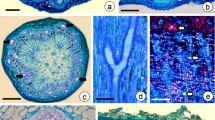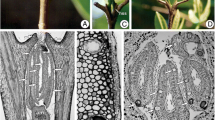Abstract
Glandular scales of Origanum dictamnus L. originate from a single protodermal cell. They are composed of a 12-celled head and an unicellular stalk and foot. During the early stages of gland differentiation, the head cells possess a small number of plastids which contain globular inclusions. Similar inclusions are also observed in the plastids of the stalk and the foot cell. The lateral walls of the stalk cell progressively undergo cutinization which does not extend to the upper and lower periclinal walls. At the onset of secretion the electron density of the plasmalemma region lining the apical walls of the head cells remarkably increases. These walls are impregnated with an osmiophilic substance identical in appearance to the content of the subcuticular space. In a following stage of the secretory process osmiophilic droplets of various size arise in the cytoplasm of the secretory cells which undergoes simultaneously a reduction of its initial density. After secretion has been concluded the protoplast of the head cells becomes gradually degenerated. The chlorenchyma cells of the mesophyll possess numerous microbodies closely associated with various organelles. In the cytoplasm of these cells crystalloids occasionally occur.
Similar content being viewed by others
References
Amelunxen, F. (1965) Elektronenmikroskopische Untersuchungen an den Drüsenschuppen von Mentha piperita L. Planta Med. 13, 457–473
Amelunxen, F., Wahlig, T., Arbeiter, H. (1969) Über den Nachweis des ätherischen Öls in isolierten Drüsenhaaren und Drüsenschuppen von Mentha piperita L. Z. Pflanzenphysiol. 61, 67–72
Benner, U., Schnepf, E. (1975) Die Morphologie der Nektarausscheidung bei Bromeliaceen: Beteiligung des Golgi-Apparates. Protoplasma 85, 337–349
Bosabalidis, A., Tsekos, I. (1982a) Ultrastructural studies on the secretory cavities of Citrus deliciosa Ten. I. Early stages of the gland cells differentiation. Protoplasma 112, 55–62
Bosabalidis, A., Tsekos, I. (1982b) Ultrastructural studies on the secretory cavities of Citrus deliciosa Ten. II. Development of the essential oil-accumulating central space of the gland and process of active secretion. Protoplasma 112, 63–70
Bronner, R. (1975) Simultaneous demonstration of lipids and starch in plant tissues. Stain Technol. 50, 1–4
Buchen, B., Sievers, A. (1978) Megasporogenese von Selaginella, II. Ultrastrukturelle und cytochemische Untersuchungen zur Sekretion von Lipiden. Protoplasma 96, 319–328
Dell, B., McComb, A.J. (1977) Glandular hair formation and resin secretion in Eremophila fraseri F. Meull (Myoporaceae). Protoplasma 92, 71–86
Dell, B., McComb, A.J. (1978) Biosynthesis of resin terpenes in leaves and glandular hairs of Newcastelia viscida. J. Exp. Bot. 29, 89–95
Dickenson, P.B., Fairbairn, J.W. (1975) The ultrastructure of the alkaloidal vesicles of Papaver somniferum Latex. Ann. Bot. 39, 707–712
Dolzmann, P. (1964) Elektronenmikroskopische Untersuchungen an den Saughaaren von Tillandsia usneoides (Bromeliaceae). I. Feinstruktur der Kuppelzelle. Planta 60, 461–472
Findlay, N., Mercer, F.V. (1971) Nectar production in Abutilon. II. Submicroscopic structure of the nectary. Aust. J. Biol. Sci. 24, 657–664
Frederick, S.E., Gruber, P.J., Newcomb, E.H. (1975) Plant microbodies. Protoplasma 84, 1–29
Frey-Wyssling, A., Mühlethaler, K. (1959) Über das submikroskopische Geschehen bei der Kutinisierung pflanzlicher Zellwände. Vierteljahresschr. Naturforsch. Ges. Zürich 104, 294–299
Gabara, B. (1977) Radioautographic visualization of incorporation of lipid precursors into anthers of Muscari comosum (L.). Mill. Acta Soc. Bot. Pol. 46, 295–302
Galatis, B., Apostolakos, P. (1977) On the fine structure of differentiating mucilage papillae of Marchantia. Can. J. Bot. 55, 772–795
Hannig, E. (1930) Über den Mechanismus der Sekretausscheidung bei den Drüsenhaaren von Pelargonium. Z. Bot. 23, 1004–1014
Heinrich, G. (1970) Elektronemikroskopische Beobachtungen an den Drüsenzellen von Poncirus trifoliata; zugleich ein Beitrag zur Wirkung ätherischer Öle auf Pflanzenzellen und eine Methode zur Unterscheidung flüchtiger von nichtflüchtigen lipophilen Komponenten. Protoplasma 69, 15–36
Heinrich, G. (1973) Entwicklung, Feinbau und Ölgehalt der Drüsenschuppen von Monarda fistulosa. Planta Med. 23, 154–166
Heinrich, G. (1977) Die Feinstruktur und das ätherische Öl eines Drüsenhaares von Monarda fistulosa. Biochem. Physiol. Pflanzen 171, 17–24
Hurkman, W.J., Kennedy, G.S. (1976) Fine structure and development of proteoplasts in primary leaves of mung bean. Protoplasma 89, 171–184
Karnovsky, M.J. (1965) A formaldehyde-glutaraldehyde fixative of high osmolarity for use in electron microscopy. J. Cell Biol. 27, 137A
Kuhn, H. (1970) Chemismus, Struktur und Entstehung der Carotinkriställchen in der Nebenkrone von Narcissus poeticus L. var. “La Riante”. J. Ultrastruct. Res. 33, 332–355
Middendorf, E. (1927) Dauerbeobachtungen über den Sekretionsvorgang an Drüsenhaaren. Beitr. Biol. Pflanz. 15, 61–92
Mitlacher, W. (1908) Über anatomische Verhältnisse der Labiaten. Österr. J. Pharm. 9, 1–25
Molisch, H. (1923) Mikrochemie der Pflanze, pp. 118–122. Fischer, Jena
Müller, R. (1905) Zur Anatomie und Entwicklungsgeschichte der Ölbehälter. Ber. Dtsch. Bot. Ges. 23, 292–297
Nagl, W. (1976) Ultrastructural and developmental aspects of autolysis in embryo-suspensors. Ber. Dtsch. Bot. Ges. 89, 301–311
Parry, J.W. (1969) Spices, vol. II. Chemical Publishing Company, New York
Pickett-Heaps, J.D. (1969) Preprophase microtubule bands in some abnormal mitotic cells of wheat. J. Cell. Sci. 4, 397–420
Pizzolato, T.D., Heimsch, C. (1975) Ontogeny of the protophloem fibers and secondary xylem fibers within the stem of Coleus. II. An electron microscope study. Can. J. Bot. 53, 1672–1697
Rachmilevitz, T., Joel, D.M. (1976) Ultrastructure of the calyx glands of Plumbago capensis Thunb. in relation to the process of secretion. Isr. J. Bot. 25, 127–139
Reynolds, E.S. (1963) The use of lead citrate at high pH as an electron opaque stain in electron microscopy. J. Cell Biol. 17, 208–218
Schnepf, E. (1969a) Über den feinbau von Öldrüsen. I Die Drüsenhaare von Arctium lappa. Protoplasma 67, 185–194
Schnepf, E. (1969b) Über den Feinbau von Öldrüsen. III. Die Ölgänge von Solidago canadensis und die Exkretschläuche von Arctium lappa. Protoplasma 67, 205–212
Schnepf, E. (1972) Tubuläres endoplasmatisches Reticulum in Drüsen mit lipophilen Ausscheidungen von Ficus, Ledum und Salvia. Biochem. Physiol. Pflanz. 163, 113–125
Schulze, C., Schnepf, E., Mothes, K. (1969) Über Lokalisation der Kautschukpartikel in verschiedenen Typen von Milchröhren. Flora 158, 458–460
Srivastava, L.M. (1966) On the fine structure of the cambium of Fraxinus americana L. J. Cell Biol. 31, 79–93
Steer, M.W. (1981) Comments on the book “Secretory tissues in plants” by Fahn, A. Ann. Bot 47, 177–178
Thaler, I., Amelunxen, F. (1975) Eiweisskristalle und Vacuoleneinschlüsse von Lilium tigrinum. Protoplasma 85, 71–84
Tsekos, I. (1974) Zur Feinstruktur der Drüsen von Ribes sanguineum Pursch. Sci. Ann. Fac. Phys. Math. Univ. Thessal. 14, 25–30
Tsekos, I., Schnepf, E. (1974) Der Feinbau der Drüsen der Pechnelke Viscaria vulgaris. Biochem. Physiol. Pflanz. 165, 265–270
Wollenweber, E., Schnepf, E. (1970) Vergleichende Untersuchungen über die flavonoiden Exkrete von “Mehl”- und “Öl”-Drüsen bei Primeln und die Feinstruktur der Drüsenzellen. Z. Pflanzenphysiol. 62, 216–227
Wooding, F.B.P. (1969) Absorptive cells in protoxylem: association between mitochondria and the plasmalemma. Planta 84, 235–238
Young, D.N. (1978) Ultrastructural evidence for a secretory function in the “gland cells” of the marine red alga Botryocladiu pseudodichotoma (Rhodymeniaceae). Protoplasma 94, 109–126
Author information
Authors and Affiliations
Rights and permissions
About this article
Cite this article
Bosabalidis, A., Tsekos, I. Glandular scale development and essential oil secretion in Origanum dictamnus L.. Planta 156, 496–504 (1982). https://doi.org/10.1007/BF00392771
Received:
Accepted:
Issue Date:
DOI: https://doi.org/10.1007/BF00392771




